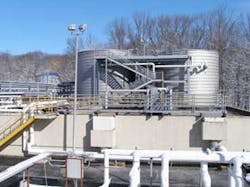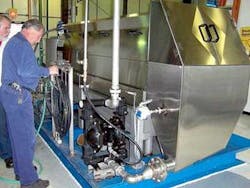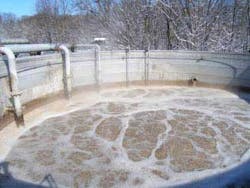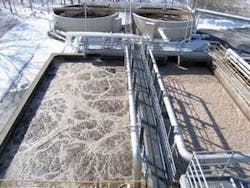A Taste for BOD5 Removal
By Chandler Johnson and Neil McAdam
• AnoxKaldnes fixed film MBBR technology boosts wastewater treatment capacity in a small footprint, with cost savings and workload relief for operators at NJ's Givaudan Flavors plant.
Outgrowing wastewater treatment capability is a troublesome burden for food processors. Management and staff must deal with the immediate problem of meeting discharge requirements while simultaneously developing strategies to expand treatment capacity to handle current demand and anticipated future loadings and restrictions. Givaudan Flavors, of East Hanover, NJ, recently faced such a dilemma. When its undersized wastewater treatment system became an Achilles' heel for this otherwise highly efficient processor, it eventually turned to innovative fixed film aerobic bioreactor technology for a solution.
Givaudan is an international company operating flavor and fragrance manufacturing facilities worldwide. Its East Hanover facility is a flavor manufacturing and extracts plant that processes vanilla beans, cinnamon bark, ginger roots, cola nuts and other natural foods sold as end products and for use in other foods. Processing these products produces 140,000 gallons per day (gpd) in liquid wastes that are treated in-house.
A ‘Compliance Nightmare'
The wastewater treatment plant serving the East Hanover facility was originally designed in the 1970s to treat 40,000 gpd with loadings of 3,000 lbs of BOD5 per day. But as production at the flavor manufacturing and extracts facility began growing in the late 1980s, resulting wastewater volumes generated eventually outgrew the treatment plant's capacity. Operators in recent years found themselves responding to a 70,000-100,000 gpd processing demand and BOD5 levels as high as 10,000 lbs/day. Effectively treating these daily oversized hydraulic and organic loads within strict federal and local discharge requirements took an intensive effort by the company's four licensed wastewater treatment plant operators and carried considerable financial consequences for the company.
“It was a compliance nightmare,” Chester Makowski, Environmental Health & Safety (EHS) manager for Givaudan Flavor's East Hanover facility, says. “We were hydraulically and organically out of capacity. Part of our immediate solution was to send out a considerable amount of our gray water to the local publicly owned treatment works (POTW), which was willing to take it for a fee.”
Sending out 40-to-50 loads of gray water — 21,000-gallon each — per month translated to exorbitant costs in excess of $350,000 a year. The plant was also sending an average of eight truckloads of activated sludge monthly to a local POTW for beneficial reuse, further adding to the considerable operating costs.
The long-term solution required a wastewater treatment plant upgrade and expansion. Makowski enlisted the aid of a local engineering firm to act as consultants in identifying and developing a viable plan to expand capacity. Qualities the company was searching for in an expanded system included: a high organics removal rate, ease of operation, and the ability to handle anticipated future loadings and potentially more stringent discharge requirements. In addition, there was little room for physical expansion. Therefore, the new system needed to have a small footprint.
After reviewing a number of proposals and following the results of an on-site feasibility study, the addition of Moving Bed™ Biofilm Reactor (MBBR™) technology from AnoxKaldnes was determined to be the most effective solution.
Fixed Film Reactors
MBBR technology is a treatment process that uses plastic media or biocarriers to grow biofilm, which is retained in reactors using media retention screens while an aeration system supplies oxygen to let the floating bacteria/biofilm provide the treatment required. Effective biomass within the bioreactor is augmented through growth on the media, and nearly all of the biomass is resident on the media itself. The process can be fit into any shape or size reactor, often allowing retrofits into existing tankage.
Givaudan's East Hanover management requested the on-site feasibility study of this process. “The system supplier came with a mobile unit and picked up a slip stream off of our equalization tank to conduct the pilot study,” Makowski says. “The pilot system demonstrated that it could remove better than 95% of the organics while also taking care of our hydraulic deficiency.”
Makowski also had the opportunity to observe a similar treatment plant retrofitted with the same MBBR technology at a Givaudan sister facility in Kemptthal, Switzerland. As with the wastewater treatment plant serving the company's East Hanover plant, the Kemptthal facility had been operating a two-stage activated sludge wastewater treatment system that had become deficient in organic and hydraulic capacity before a recent upgrade using the biological fixed film technology. The Swiss staff was quite satisfied with the upgrade, and a strong turnaround there added to the decision to deploy it at Givaudan's East Hanover facility.
Although MBBR systems are often installed in existing tankage, implementation of the Givaudan plant expansion project in East Hanover required installation of two reactor tanks upstream of the existing activated sludge system. Effluent from the biofilm system flows via gravity directly to the downstream activated sludge system. Therefore, it “seeds” the downstream reactor.
A Standa-Alone Process
The AnoxKaldnes technology is a stand-alone process without a need for backwashing, returning sludge or recycling wastewater. The core principle is to have a continuously operating, non-clogging biofilm reactor with no backwashing, low head-loss and a high specific biofilm surface area.
The basis of the process is the biofilm carrier elements. Made from polyethylene, they provide a large protected surface area for the biofilm and optimal conditions for the bacteria culture to grow and thrive in the reactor tank. Since the biofilm created around each carrier element provides a more stable environment for the bacteria to grow, less space is required compared to other biological systems and fewer control points.
A stainless steel wedgewire sieve is used to retain the media within each reactor. The vigorous action of the moving bed continually scours the surface of the sieve, eliminating need for maintenance. A perforated, stainless steel aeration grid mounted at the bottom of the reactor is connected to high efficiency blowers, producing a medium-sized bubble that evenly diffuses the oxygen across the bottom surface of the tank to provide the necessary mixing. The MBBR systems serving the East Hanover plant uses two 32'-diameter reactor tanks, each with a 30' water depth, providing a volume capacity of about 180,000 gallons.
The facility upgrade also included several modifications of existing processes, including upgrading the activated sludge aeration basins from an outdated diffuser system to AnoxKaldnes medium bubble aeration to maintain dissolved oxygen (DO) levels in the mixed liquor suspended solids (MLSS) tanks. In addition, the plant's digesters were modified to include jet mixing and aeration. “The new jet mixers provide the oxygen that we needed in order to retain the activated sludge on-site a little longer while we dewater,” Makowski says. “We also replaced our gravity belt thickener with a rotary drum thickener.”
High BOD5 Removal
Full operation of the new system began in April 2008. According to Makowski, the MBBR process has proven successful in significantly increasing organic removal capacity of the existing aerobic biological treatment system while minimizing new aerobic tankage. It has expanded the facility's design capacity from 3,000 lbs BOD5/day to 18,100 lbs BOD5/day. The design flow is 140,000 gpd effluent at 15,500 mg/L BOD5, and the MBBR process is capable of removing 11,600 lbs per day BOD5.
“We have a lot of corn syrup, sugars, flavors and flavor extracts, so our treatment plant's incoming BOD5 is rather high,” Makowski says. “Based on flow and depending on the organic loading for the day, our current influent BOD5 is between 8,000 and 10,000 lbs per day. With the new MBBR systems preceding our upgraded activated sludge system, we're now getting better than 98% BOD5 removal efficiency. Our discharge BOD5 levels are currently in the 50-60 mg/L range, well below our permit limit of 300 mg/L.”
With the MBBR process, DO concentration is the critical measurement for process control. The system self-regulates as long as a positive DO level (minimum 2-3 mg/L DO) is maintained in the reactor to ensure an active biomass. To achieve this, each system is equipped with fully automated DO control that continuously adjusts blower speed based on the current DO measurements in the reactor. This saves operators time and reduces power consumption.
Since commencement of full operation, Makowski says no gray water removal due to system overload has been necessary. Eliminating the cost of gray water disposal has reduced expenditures of $350,000 to $375,000 annually, which is helping to defray the plant upgrade cost. Although energy use is slightly higher, this increase has been minimal compared to the savings by eliminating the “drastic measure” processes and procedures that had brought long-term financial drain.
Also, the addition of jet mixing and aeration to the facility's digesters as well as the rotary drum thickener have enabled the facility to digest and thicken sludge for more than four weeks without hauling. Solids concentration in the waste sludge has been consistently increased from 1-1.5% to over 4% solids. Previously, waste sludge hauling needed to be performed twice weekly.
Effective Treatment, Better Sleep
Before the treatment plant upgrade and expansion, operating and managing the overburdened plant and executing the necessary contingencies exacted a considerable toll on the operating staff at the Givaudan Flavors East Hanover plant. Despite these difficulties and associated daily stress, the plant always adhered to a high standard of excellence.
“As overloaded as it became, the plant had gone 15 years without a notice of violation, and this feat can be attributed to the efforts of our plant operators,” Makowski says. “It's their dedication that kept this system in operation. Our operators are very satisfied with the performance of this new system, and we're all now able to sleep a little better at night.”
About the Authors: Neil McAdam is Food & Beverage Market director at N.A. Water Systems LLC, a unit of Veolia Water Solutions & Technologies (VWS). Contact: 704-948-4093, [email protected] or www.nawatersystems.comVWS serves the food and beverage processing industry with a range of solutions, including feasibility and compliance studies, advanced water and wastewater treatment technologies and turnkey installations.
Chandler Johnson is vice president of AnoxKaldnes, a VWS North America product line marketed by N.A. Water Systems in industrial applications. Contact: 401-270-3898, [email protected] or www.anoxkaldnes.com





